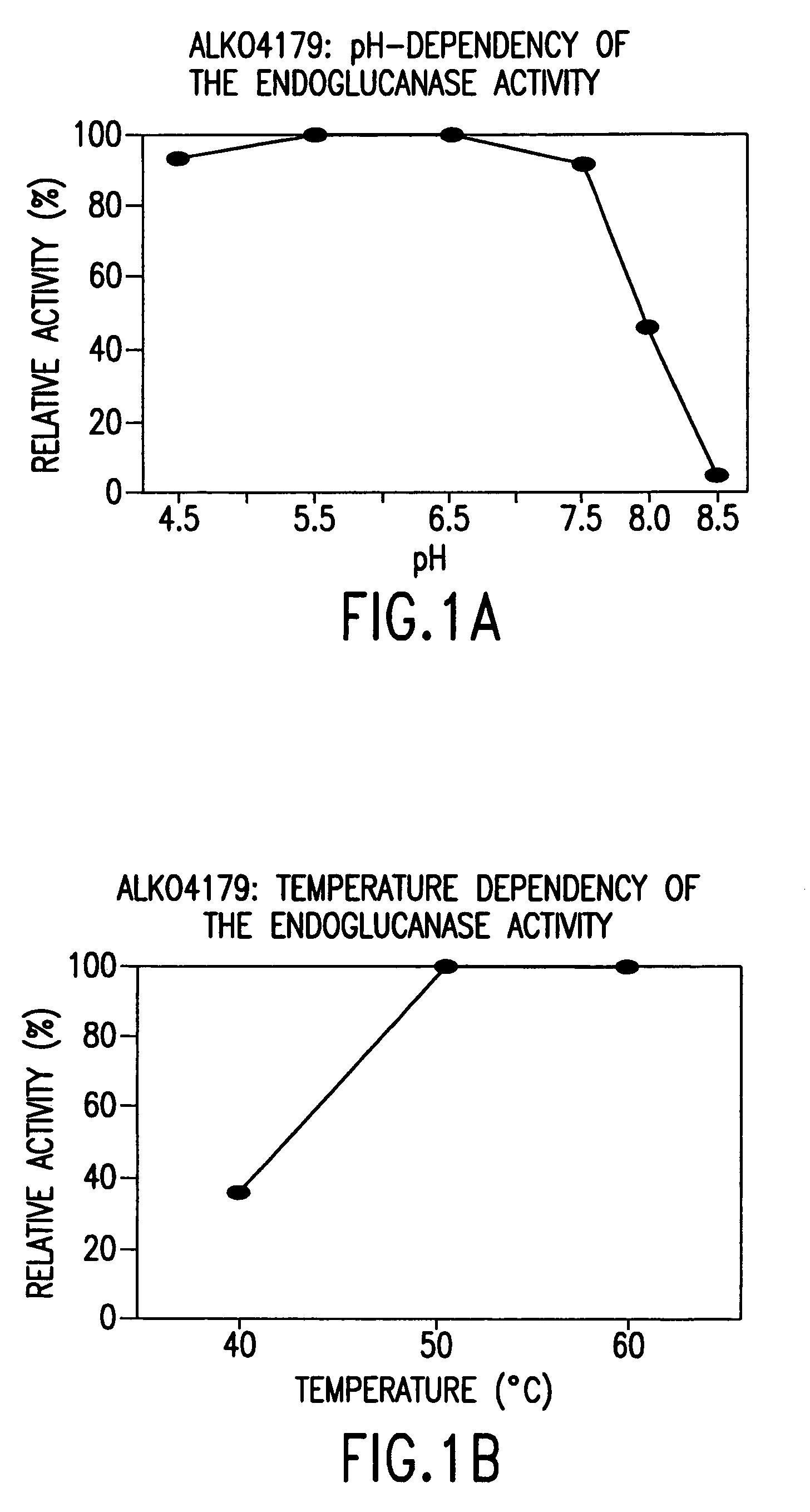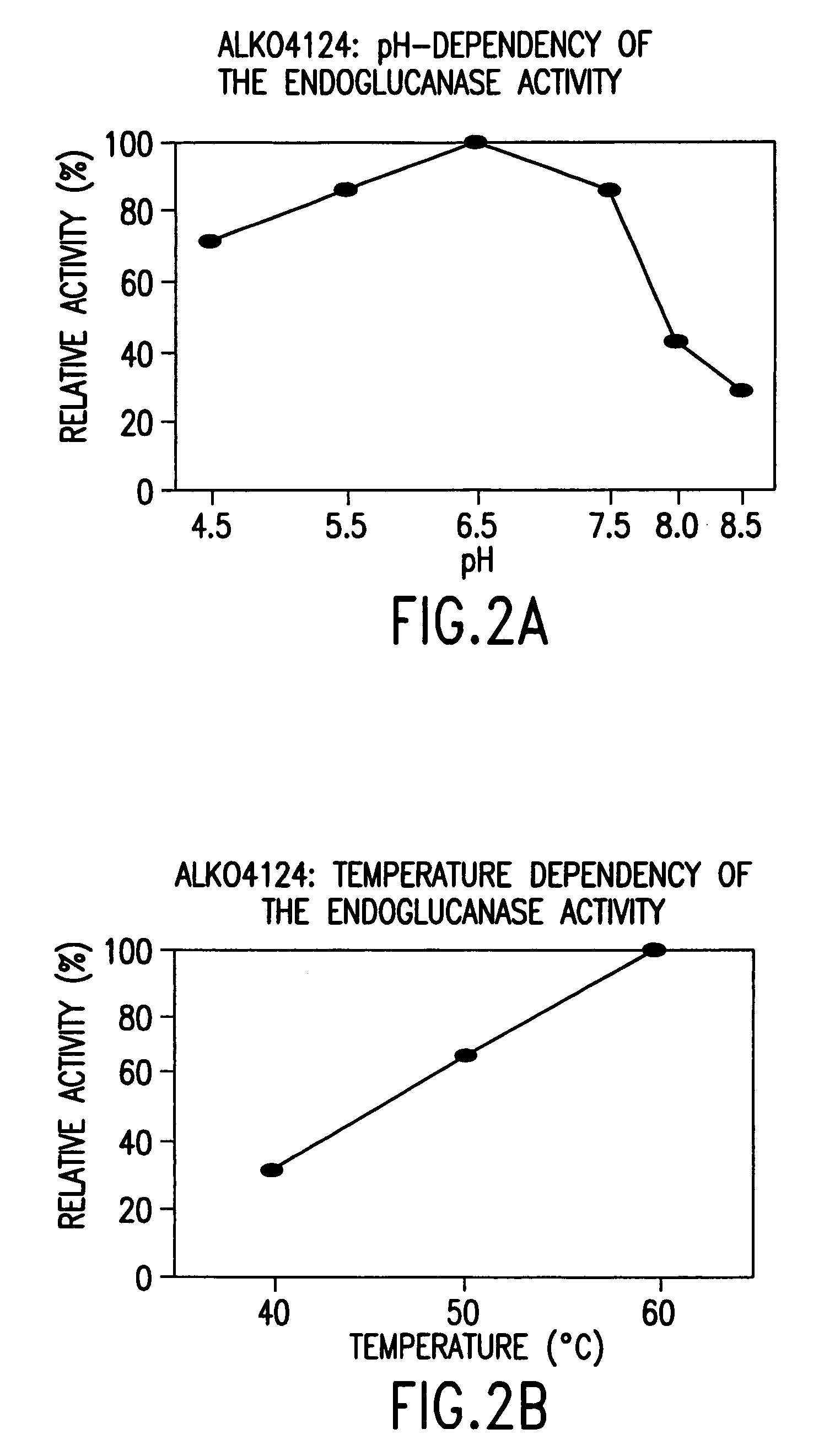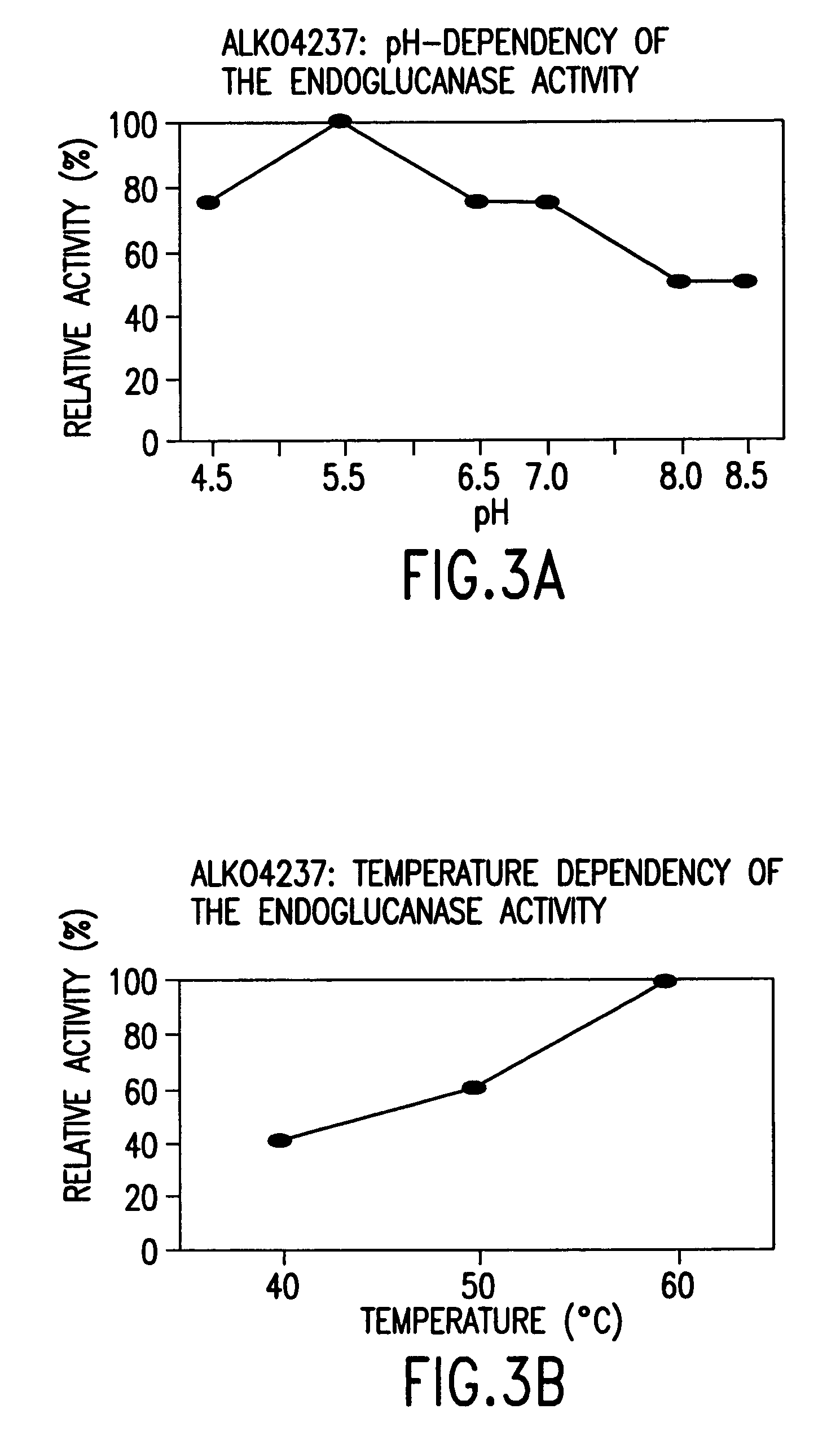Cellulases, the genes encoding them and uses thereof
a cellulase and gene technology, applied in the field of genes encoding novel neutral cellulases, can solve the problems of affecting the characteristics of fabrics, affecting the practical use of cellulases, damage to machines, sewage processing equipment, etc., and achieves the effect of enhancing the performance, stability, or buffering the desired enzyme preparation
- Summary
- Abstract
- Description
- Claims
- Application Information
AI Technical Summary
Benefits of technology
Problems solved by technology
Method used
Image
Examples
example 1
Shake Flask and Fermentor Cultivations
[0159]For maintenance, the strains ALKO4179, ALKO4124, ALKO4237, ALKO4265 and ALKO4125 were streaked on sporulation agar (ATCC medium 5, American Type Culture Collection, Catalogue of Filamentous Fungi, 18th edition, eds., S. C. Jong and M. J. Edwards, (1991): 1 liter contains 1 g yeast extract, 1 g beef extract, 2 g tryptose, a trace amount of FeSO4, 10 g glucose and 15 g agar; the pH was 7.2. Agar slants were incubated at 45° for 3-6 days.
[0160]For the applications tests of ALKO4237 (Examples 3 and 4), a colony was inoculated in 500 ml of the following mineral medium (Moloney, A. P. et al., Biotechnol. Bioeng. 25:1169 (1983)): 1 liter contains 15 g KH2PO4, 15 g (NH4)2SO4, 2.4 ml of 1 M MgSO4×7H2O, 5.4 ml 1 M CaCl2, 20 g Solka floc, 15 g corn steep powder, 1 g yeast extract and 10 ml 100× trace element solution 1, where 1 liter of 100× trace element solution 1 contains 0.5 g FeSO4×7H2O, 0.156 g MnSO4×H2O, 0.14 g ZnSO4×7H2O and 0.49 g CoSO4×7H2O...
example 2
Determination of the pH and the Temperature Dependence of the Endoglucanase Activities in the Culture Filtrates
[0167]For the determination of pH and temperature dependence, the strains ALKO4179, ALKO4124, ALKO4237, ALKO4265 and ALKO4125 were grown in the modified thermomedium B. Samples from the shake flask cultivations (culture filtrates) were diluted in 50 mM McIlvain's buffers (50 mM citric acid-100 mM Na2HPO4) of pH range 4.5-8.5. The final pH values of the culture filtrate buffer mixtures were 4.3, 5.4, 6.3, 7.3, 8.1 and 8.7 for the strain ALKO4179; 4.3, 5.4, 6.4, 7.3, 8.1 and 8.5 for the strain ALKO4124; 4.4, 5.3, 6.2, 7.1, 8.0 and 8.5 for the strain ALKO4237; 4.3, 5.4, 6.3, 7.2, 8.1 and 8.5 for the strain ALKO4265 and 4.3, 5.4, 6.4, 7.3, 8.1 and 8.5 for the strain ALKO4125. BSA was added as a protein carrier to the concentration of 100 μg / ml. Pepstatin A and phenyl methyl sulphonyl fluoride (PMSF) were added as protease inhibitors at 10 μg / ml and 174 μg / ml, respectively. Endo...
example 3
Indigo Dye Release in Neutral Conditions
[0169]Cellulase preparations derived from the strains ALKO4179, ALKO4124, ALKO4237, ALKO4265 and ALKO4125 (Examples 1 and 2) were tested for their ability to release dye in neutral conditions from the indigo dyed cotton-containing denim fabric to give a stone-washed look. Commercial acid cellulase product Ecostone L (Primalco Ltd, Biotec, Finland) was used as a control.
[0170]Denim fabric was obtained from Lauffenmuehl (Germany). Test fabric was prewashed 10 min at 60° C. with Ecostone A 200 (1 ml / liter, Primalco Ltd, Biotec, Finland). The fabric was then cut into 12×12 cm swatches. The colour from both sides of the fabric swatches was measured as reflectance values with the Minolta (Osaka, Japan) Chroma Meter CM 1000R L*a*b* system.
[0171]Cellulase treatments were performed in LP-2 Launder-Ometer (Atlas, Ill., USA) as follows. About 7 g of denim swatches were loaded into the 1.2 liter container that contained 200 ml of 0.05 M citrate / phosphate ...
PUM
| Property | Measurement | Unit |
|---|---|---|
| pH | aaaaa | aaaaa |
| pH | aaaaa | aaaaa |
| temperature | aaaaa | aaaaa |
Abstract
Description
Claims
Application Information
 Login to View More
Login to View More - R&D
- Intellectual Property
- Life Sciences
- Materials
- Tech Scout
- Unparalleled Data Quality
- Higher Quality Content
- 60% Fewer Hallucinations
Browse by: Latest US Patents, China's latest patents, Technical Efficacy Thesaurus, Application Domain, Technology Topic, Popular Technical Reports.
© 2025 PatSnap. All rights reserved.Legal|Privacy policy|Modern Slavery Act Transparency Statement|Sitemap|About US| Contact US: help@patsnap.com



